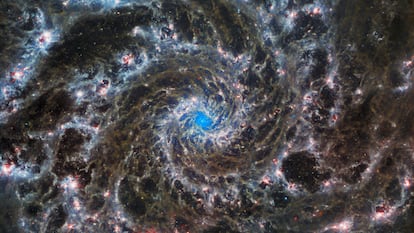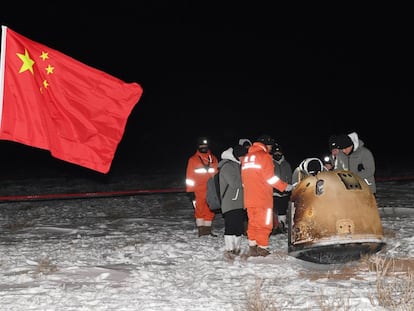How did our atoms get here?
One of the most challenging problems for astrophysicists is understanding how star and planet formation works on a cosmic scale

On her first day of skating, my daughter told me that the most important thing is to learn how to fall correctly. My professional brain took over, and I thought, “Okay, skating is similar to physics, where the most important and complex subject is understanding how things fall.” The key to our existence on Earth and the existence of our planet, our Sun, and our galaxy is understanding how a portion of the matter that makes up the universe has “fallen” to a specific place. I put that verb in quotation marks because, on a cosmic scale, the concept of falling is not easily grasped. Let me explain, or at least try, because although this is one of the great questions that humanity has been asking for millennia (and astrophysicists are still asking), we still (I am being optimistic) do not understand it well. The subject is so complicated that it will take me several weeks just to get started. Nevertheless, I will begin today by talking about why things fall.
Let’s start with the most common and perhaps easiest example – why do things fall to Earth? Aristotle once said, “A stone’s natural tendency, if left alone and unsupported, is to fall.” Why? He said it was because the stone and the earth were made of a similar substance and the stone was seeking its natural place. Thousands of years later, you would answer, “Easy! Because of its weight.” That’s precisely what the dictionary says – to fall is to move downward, propelled by one’s weight. If you know a little more about physics, you would say things fall due to the effect of gravity or the gravitational force associated with the mass of the Earth. All three answers are correct to some extent. However, they do not fully describe reality. We must move into the realm of advanced physics to explain concepts beyond nature, weight and force.
But I don’t want to stop there – I want to see how falling things stop. What I intend to do now is jump ahead and ask what happens after something starts to fall. Gravitational acceleration causes falling bodies to increase in velocity. Ignoring, for now, the effects of air resistance that slow objects down, a free-falling body will go faster and faster. Let’s leave this hanging momentarily and move on to another concept.
The history of the universe is like a George R.R. Martin novel — a neverending song of ice and fire (so far). When gas clouds with hydrogen reach icy temperatures of -328°F (-200°C) or less, stars form. Compared to that primeval gas, stars are superhot entities. The stars eventually die, and their synthesized elements of oxygen, phosphorus and iron cool down again because they are surrounded by a cosmos with an average temperature of -454°F (-270°C), which is only a few degrees above absolute zero. These elements start forming cold clouds that heat up again and birth planets with life-supporting temperatures. Cold and hot – words we use when talking about temperature.
In fact, temperature measures the speed of air molecules in our atmosphere or atoms in the gas clouds that produce stars. Here, we introduce what’s needed to continue our story about how things fall. When things fall, they go faster and faster, increasing their temperature. And if the temperature of a gas rises, how can cold clouds form? Without cold clouds, there cannot be areas where matter becomes denser, which is necessary to form stars and planets.
Back on Earth, falling objects gain velocity (kinetic energy), and the result (whether or not the object knows how to fall like the skater) is a collision with the planet’s surface. Unless its kinetic energy is high enough, the crash will convert all that energy into deformation, vibration (and therefore sound), heat and more. In other words, the energy transfer will cause the atoms of both objects (the ground and the falling object) to move faster. Sometimes the force of the collision will agitate atoms so much that they no longer (macroscopically) look like solids and become liquids (where atoms and molecules move even more) or gases.
Now that we know what it means to fall to Earth let’s apply it to the universe. For stars, planets and life to form, there must be cold clouds with densities increasing until they reach those of the Sun and Earth. For these clouds to form, matter must fall to a specific place because the universe is far less dense than the clouds that give rise to stars — imagine atoms falling due to gravitational pull (although there is no up or down in the cosmos to give meaning to the word “fall.”) But… gravity from what? And if the atoms fall, they will gain velocity and increase their temperature. So how do they cool down enough to form the clouds that where stars are born? There is no planetary surface to stop the fall and lose their kinetic energy. Questions abound. Does all matter fall at the same rate into these clouds to form stars, or do some things fall faster? Does matter fall at the same rate within planetary systems as on larger, galaxy-sized scales?
As you can see, there are many more questions than answers. I warned you – it’s complicated. It’s the most complex subject in the world or even the universe, and some of us are dedicating our lives to figuring it out.
Pablo G. Pérez González is a researcher at the Astrobiology Center, part of Spain’s National Research Council and the National Institute of Aerospace Technology (CAB/CSIC-INTA)
Sign up for our weekly newsletter to get more English-language news coverage from EL PAÍS USA Edition
Tu suscripción se está usando en otro dispositivo
¿Quieres añadir otro usuario a tu suscripción?
Si continúas leyendo en este dispositivo, no se podrá leer en el otro.
FlechaTu suscripción se está usando en otro dispositivo y solo puedes acceder a EL PAÍS desde un dispositivo a la vez.
Si quieres compartir tu cuenta, cambia tu suscripción a la modalidad Premium, así podrás añadir otro usuario. Cada uno accederá con su propia cuenta de email, lo que os permitirá personalizar vuestra experiencia en EL PAÍS.
¿Tienes una suscripción de empresa? Accede aquí para contratar más cuentas.
En el caso de no saber quién está usando tu cuenta, te recomendamos cambiar tu contraseña aquí.
Si decides continuar compartiendo tu cuenta, este mensaje se mostrará en tu dispositivo y en el de la otra persona que está usando tu cuenta de forma indefinida, afectando a tu experiencia de lectura. Puedes consultar aquí los términos y condiciones de la suscripción digital.
More information
Últimas noticias
The life of a delivery driver in China: ‘Many people don’t know how an order can arrive at their home in just one day’
Maude Apatow, from acting in ‘Euphoria’ to directing: ‘There are many films that you can tell weren’t written by someone young’
The guardians of the meteorites of the Argentine Chaco
Helen Levitt, the photographer who captured the theater of the everyday
Most viewed
- Christian Louboutin: ‘Young people don’t want to be like their parents. And if their parents wear sneakers, they’re going to look for something else’
- US sanctions against jailed cartel leader ‘El Marro’ highlight Mexico’s lack of control over its prisons
- Cartels in Mexico take a leap forward with narco-drones: ‘It is criminal groups that are leading the innovation race’
- Liset Menéndez de la Prida, neuroscientist: ‘It’s not normal to constantly seek pleasure; it’s important to be bored, to be calm’
- ‘El Limones’ and the growing union disguise of Mexican organized crime











































